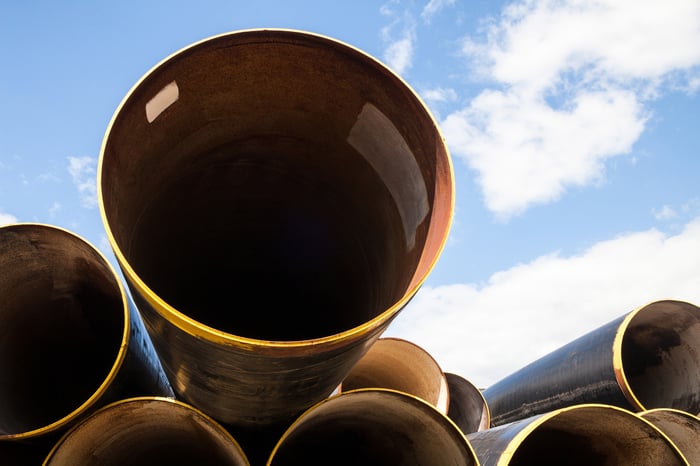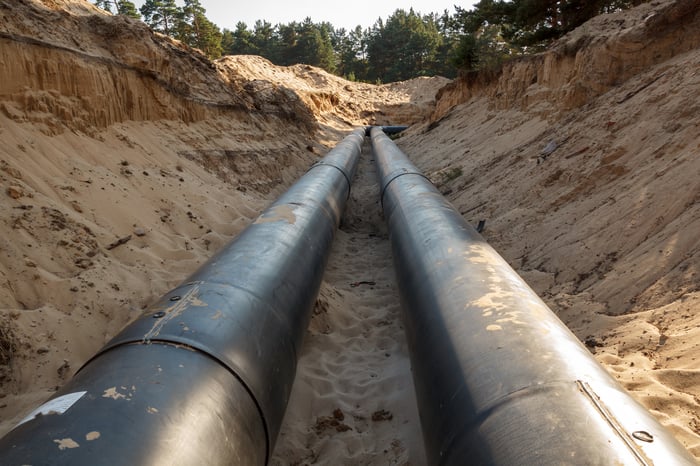Oil drillers have been snapping up land in the Permian Basin at a fevered pace over the past few years to stake their claim on some of the best drillable land in the world. In the process, they've begun unlocking a treasure trove of oil, which has catapulted their production. However, they've started to encounter one major problem: There's not enough pipeline capacity to get this oil out of the region. Because of that, regional oil prices have deflated, which is weighing on the stock prices of producers solely focused on the Permian.
That growing problem, though, is creating new opportunities for pipeline companies to expand. Several have projects in the works, which should fuel growth for their investors in the coming years.

Image source: Getty Images.
Running out of room
Rapidly rising oil production due to higher prices has gobbled up a significant portion of the currently available pipeline capacity coming out of the Permian. As a result, regional oil prices trade nearly $20 below the global oil benchmark level. That deeply discounted oil price is weighing on the stock market values of Permian producers.
According to a report by Bloomberg, pure-play Permian drillers have lost more than $15 billion in market value in the past few weeks as the difference between the two oil prices widened. Among the hardest-hit oil stocks has been Concho Resources (CXO), which is in the process of becoming the largest shale producer in the Permian with its purchase of RSP Permian. In the past month alone, Concho's market value has declined by nearly $4 billion to $19 billion. It's not alone as several other pure-play Permian drillers have also shed billions of dollars in market value over the past few weeks due to falling oil prices in the region.

Image source: Getty Images.
The building boom
While pipeline capacity constraints have hurt producers focused on the Permian, it has been a boon for midstream companies in the region, which have been able to quickly sign up shippers for proposed expansion projects. Private equity-backed EPIC Midstream was able to get major Permian producers Apache (APA -1.66%) and Noble Energy (NBL) to sign up for a combined 175,000 barrels per day (BPD) on the company's proposed EPIC Crude Oil Pipeline. EPIC currently plans to build a 440,000 BPD pipeline to ship crude out of the Permian. However, it could expand the line up to 675,00 BPD if there's enough shipper demand. One of the reasons Noble was quick to sign on is that this line "provides long-term flow assurance for our rapidly growing Delaware Basin oil volumes," according to the company. Apache, meanwhile, stated that this line "enhances our long-term operational flexibility and market optionality." EPIC hopes to start construction on the pipeline later this year, which would put it in service by the second half of 2019. It's one of the first projects by the private equity-backed start-up but likely won't be its last given the infrastructure needs in the region.
It's also just one of several oil pipeline projects in the works throughout the Permian Basin. Plains All American Pipeline (PAA -1.35%) is currently investing $1.6 billion on Permian Basin expansions, which include two long-haul pipelines and several other complementary projects to help de-bottleneck the flow of crude. Those projects help position Plains to grow earnings and cash flow at a double-digit annual pace over the next two years, setting it up to increase its 4.9%-yielding payout at a healthy rate going forward.
In the meantime, Magellan Midstream Partners (MMP) is working on a 600,000 BPD pipeline in the region that could be in service by the middle of next year. Magellan is currently evaluating other options such as a joint venture that could optimize the project, which might shift the time frame and scale of the project. In addition, Magellan is eyeing a potential oil export dock in Corpus Christi, Texas, which it sees as an ideal landing spot for crude coming out of the Permian. The up-to-$700 million project could be up and running by 2020 and give Permian producers access to higher global oil prices. Projects like those potentially position Magellan to continue increasing its 5.4%-yielding distribution at a mid-single-digit annual rate for the next several years.
A problem for one is an opportunity for another
Pipeline constraints in the Permian have cost oil stock investors billions of dollars in lost market value in recent weeks. However, that problem is turning out to be a massive opportunity for pipeline companies, which are investing billions to build new lines that should grow their cash flows in the coming years. Pipeline stocks could therefore be one of the big winners from the Permian boom. Meanwhile, as those pipelines come on line, they should help boost regional oil prices, which could lift the weight currently holding down Permian-focused oil stocks.


